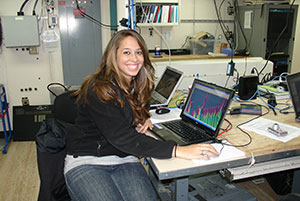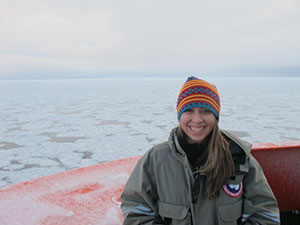
Meet Shannon Hoy
Shannon Hoy is a former Explorer-in-Training who has spent over 100 days at sea and has already developed a broad portfolio in the ocean sciences, from biology and ecology to geology and seafloor mapping. Read the full text of Shannon's interview below to learn more about her experiences on the ship.
About Shannon's Role
What were your duties as an Explorer-in-Training? Where was your work experience located? If you were working at sea, what were your impressions of living and working on a ship?
I was fortunate to participate in two NOAA Okeanos Explorer cruises in 2010. The first was the ship shakedown cruise, operational area Hawaii, and the second was the transit cruise from Indonesia to Guam to Hawaii.
My general duties included standing watches, typically midnight watches (nothing like being surrounded by ocean in the dead of night), maintaining the log, processing multibeam data, and deploying Expendable Bathy Thermographs (XBTs) for sound velocity acquisition.
I thoroughly enjoy life at sea. It is a quite different environment, being that you live and work with people you have just met. Life at sea is hard work, long hours, and interesting living conditions; however, I have yet to participate in anything more rewarding.

Shannon on her first research cruise was on the R/V Ronald H. Brown. Here, she is learning seafloor mapping for the first time.
Which school are you attending?
I recently graduated from the College of Charleston with a B.S. in Marine Biology. Currently, I work at the U. S. Geological Survey in Woods Hole, Massachusetts, for the Coastal and Marine Geology-Marine Geohazards group as a Research Associate learning more about submarine landslides and their role in generating tsunamis.
What sparked your initial interest in ocean sciences?
I have been interested in ocean sciences for as long as I can remember. Growing up in landlocked Dallas, Texas, I was always mystified by the ocean. I remember being six years old and being enthralled with tidal pools on a family vacation to Morro Bay, California. Ever since then, I have dedicated myself to becoming an ocean scientist.

Shannon on the RVIB Nathaniel B. Palmer off the coast of Antarctica.
What was the most personally rewarding part of your experience?
For me, the time I have spent at sea is a collection of rewarding experiences and it is difficult for me to choose one. First, the connections I made while participating with the Okeanos Explorer cruises have shown to be invaluable as I continue to move forward in my career. Marine science in general is a small field and I have yet to go to a conference or interview for a job where my connections have not been useful.
Secondly, being able to experience life on a ship surrounded by the ocean is completely humbling. Each time I go out to sea, I am amazed by the perspective I am able to achieve and grateful for the time to disconnect from the distractions of daily life.
Lastly, I have been able to see and participate in numerous experiences that most people are unable to. I have seen beautiful places and experienced wonderful cultures from Indonesia to Chile to Antarctica. I have lived the same day twice while crossing the International Date Line on board the Okeanos Explorer. I have had the opportunity to see pods of dolphins surrounded by glowing bioluminescence riding the bow wake at night, penguins loitering on floating icebergs off the coast of Antarctica, and the endangered Northern Atlantic Right Whale passing by the ship in the Gulf Stream.
Please describe your final project.
During the ship shakedown cruise of 2010, my fellow explorer Karma Kissinger and I created a poster (pdf, 1.6 MB) on conducting a multibeam patch test, which is used to calibrate the multibeam sonar system after months of being unused.
Throughout the transit cruise from Indonesia to Hawaii, I was involved in multiple small projects while on board. My first project was to process the three months of raw multibeam data collected by the Indonesian research vessel Baruna Jaya. My second project was to write a section of the final cruise report on the capability of our EM302 multibeam sonar reaching depths of 8,000 meters as we crossed the Mariana Trench.
How do you see this experience fitting in with your future career plans?
This experience has been integral to my choice of career path. I have spent 110 days at sea, starting as a multibeam junior mapper and ending as a multibeam specialist. Each time I go out to sea, I make more connections and learn about fascinating aspects of the ocean. After my contract with the U.S. Geological Survey, I will be participating in a 45-day cruise as a multibeam technician from the Canary Islands to Trinidad and Tobago on board the British ship the R/V James Cook.
As for my final career, the possibilities are endless. I have had extensive experience in multiple aspects of ocean science: biology, ecology, geology, and seafloor mapping. I enjoy looking at the ocean as an entire system rather than specializing in one discipline. Who knows where or what I will be doing 10 years from now? I could be a seafloor technician, a policy maker for conservation of the oceans, or a geologist working in understanding tsunamis. Whatever I end up doing, I am certain I will be working to preserve the oceans.